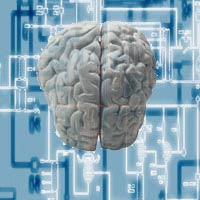Hi Gang,
Last week I attended a conference specifically dedicated to multi-electrode interfacing with biological neural systems - SIMEA 2003. Here are the highlights:
Keynote speech by Rudolfo Llinas, a living legend among neuroscientists, about multielectrode recording from the Inferior Olive, the relay station for all motor commands in the nervous system. He showed why all repetitive human movement is limited to about 10 times per second (10 Hz) max and how this system interfaces motor commands between the brain and the body.
Excellent talk by Miguel Nicolelis on interfacing the brain of a macaque monkey to a system that allows it to play video games simply by thinking about it. The monkeys have faster learning curves and reaction times than monkeys trained with joysticks. The system is using over 200 implanted electrodes in various parts of the brain, mostly in the motor cortex.
New electronics are being developed which will minaturize and drop the price on the systems we are currently using. There is an ongoing debate about the use of micro-electrodes versus field effect transistors as recording devices for neurons.
Multiparametric chips are close to completion which allow recording of electrical signals, gas levels (O2 & CO2), pH, temperature all on one chip. A future development planned is the inclusion of biosensors which could sense things like neurotransmitters.
The defense department is funding an effort to use use neurochips as bio and chemical warfare sensors. The chip with cultured neurons would be plugged into a box which would record the signal reaction of the neurons when exposed to various environmental molecules. As a cute aside, one of the researchers mentioned that the current state of the art system used by the Army is the Kuwaiti Field Chicken (Army acronym KFC, no kidding) If the chicken drops dead you put on your gas mask.
Patterned cultures in which neurons are grown in specific places and their connections are specified are coming along now. Trails of proteins which neurons like and dislike are laid down to specify where they will grow. This may give us the ability to define the networks instead of growing them randomly as we do now. (Best one liner of the conference - "You can lead a growth cone to a neuron but you can't force it to synapse" Dr. G. Gross)
Lots of good technical presentations on growth medias, stimulation conditions, mathematical models of signalling, software, and robot interfacing too.
Best,
Ocsrazor












































